Press Releases
It’s Fall. Time To Tune Up Your Home For Winter!!
Fall means leaves changing colors, farmers getting crops in from the fields, shorter days, and cooler temperatures. And while it hasn’t really gotten cold yet, now is the time to begin to think about getting your home ready for the coming winter. By putting in some work now, you can remain cozy and save money all winter long. Here’s a few tips to consider:
Change Furnace Filters:
It’s easy to forget to replace your filters, but it’s important to do so once a month during heating season. Dirty filters restrict airflow and increase energy demand. HEPA filters are a great choice and may remove as much as 99.97% of airborne particles, making the air you breathe in your home much safer, as well. Mark a date on your calendar to help remind you.
Tune Up / Replace Your Heating System:
You probably already know that cars need periodic tune-ups in order to run their best. Well, the same is true for heating equipment. Keeping your furnace clean, lubricated and properly adjusted will reduce energy use, saving up to 5 percent of heating costs.
The good news is many utilities offer free annual checkups by qualified technicians—but you often have to call early, as HVAC crews get backed up once heating season starts. Some furnace manufacturers and dealers also offer free or discounted inspections.
If your entire furnace is in need of replacement, it will cost a lot more—but replacing an inefficient burner for a modern machine will save you money every month through the heating season. Be sure to take advantage of federal tax credits for new furnaces, which can cover 10 percent of cost up to $500 or a specific amount from $50 to $300. This tax credit expires December 31, 2016, so act now.
Turn Down Your Water Heater:
While many conventional water heaters are set to 140 degrees Fahrenheit by installers, most households don't need that much steam, and end up paying for it—in dollars and the occasional scalding burn. Lowering the temperature to 120 degrees Fahrenheit (or lower) would reduce your water heating costs by 6 to 10 percent.
Dodge the Drafts:
According to the U.S. Department of Energy, drafts can waste 5 to 30 percent of your energy use. Start simple and adopt that old Great Depression fixture—the draft snake, which you can easily make yourself. Just place a rolled bath towel under a drafty door, or make a more attractive DIY draft snake with googly eyes, felt tongues and the like. You can use any scraps of fabric, even neckties, and fill with sand or kitty litter for heft.
Install Storm Doors And Windows:
The simple act of installing a storm door can increase energy efficiency by 45 percent by sealing drafts and reducing air flow. Storm doors also offer greater flexibility for letting light and ventilation enter your home. Look for Energy Star-certified models.
Similarly, storm windows can make a huge difference when the cold wind starts blowing. It may be a pain, but it is well worth it to get them out of the shed or attic and install them for the season. (Make sure each is securely shut—they don't do much good if you leave them in the up position by mistake!)
Federal tax credits are available at 10 percent of cost (not including installation costs), up to $200 for windows and skylights and up to $500 for doors. Cumulative maximum tax credits for windows, doors and skylights for all years combined is $500.
Insulate Your Pipes:
Pay less for hot water by insulating pipes. That can also help decrease the chance of pipes freezing, which can be disastrous. Check to see if your pipes are warm to the touch. If so, they are good candidates for insulation. (Use the same method to determine if your hot water heater would benefit from some insulation.)
You can get pre-slit pipe foam at most hardware stores. Cut it to size and fasten in place with duct tape. Ideally, choose the insulation with the highest R-value practical, which is a measure of its heat-blocking power. Pipe insulation is often R-3, or, for batt styles that you wrap around, a stronger R-7.
Use Caulking And Weatherstripping:
Simple leaks can sap home energy efficiency by 5 to 30 percent a year, according to the U.S. Department of Energy. That means it pays to seal up gaps with caulking and weatherstripping.
Take a close look at places where two different building materials meet, such as corners, around chimneys, where pipes or wires exit, and along the foundation.
Mind That Thermostat:
It's easy to forget to turn down the heat when you leave the building, but doing so is one of the surest ways to save money. Most households shell out 50 to 70 percent of their energy budgets on heating and cooling, so why pay for what no one uses?
For every degree you lower the thermostat during heating season, you'll save between 1 and 3 percent of your heating bill. Make it easier with a programmable thermostat. They are widely available for as little as $50, and the average family will save $180 a year with one.
Run Ceiling Fans In Reverse:
Most people think of fans only when they want to be cool, but many ceiling units come with a handy switch that reverses the direction of the blades. Counterclockwise rotation produces cooling breezes, while switching to clockwise makes it warmer. Air pooled near the ceiling is circulated back into the living space—cutting your heating costs as much as 10 percent!
Following these basic tips can keep your hard-earned dollars in your pocket, where they belong! For more info, visit: http://www.popularmechanics.com/home/interior-projects/how-to/g52/winterize-home-tips-energy-461008/



